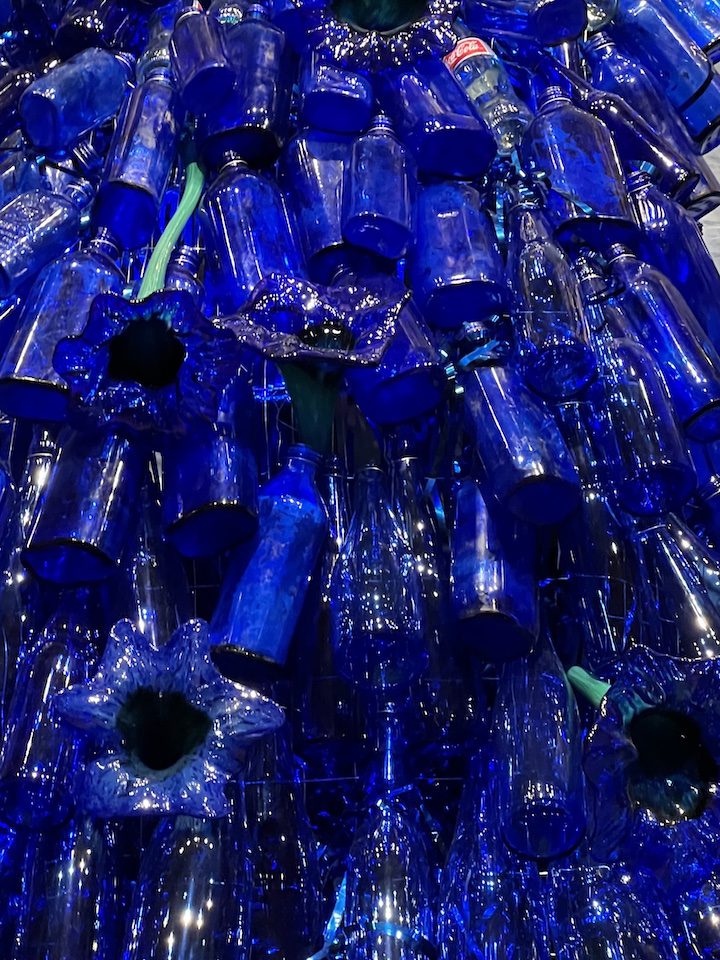
I missed the announcement of the spring opening, or maybe there wasn’t one given Covid restrictions, so it took me awhile to get myself to the Frick Museum to experience Vanessa German’s installation, Reckoning; Grief and Light.
I was drawn first by the artist, an African American Pittsburgh woman I’d met when I first came to town in 2005. We were both part of a site-specific dance performance of the Mary Miller Dance Company held in a downtown warehouse.
Vanessa was featured as a spoken word artist, one of her many gifts. Now with an international reputation due to her own site-specific installations, Vanessa describes herself as a “citizen artist.” She calls her work, “experiments with freedom,” addressing the questions our country needs to be asking in this critical time of reckoning. “How can I be whole here? How can WE be whole here? How do WE heal?
The topic draws me in. As a dancing social worker and grief advocate, I know the role the arts can play to help us metabolize our grief from large scale societal trauma and loss. As an improv artist, I appreciate the role installation art can play in connecting the dots between personal experience and societal events. We all watched on our television screens as a black man was being murdered by a policeman. And more lives lost since then, in the streets, and in their own homes. We’re grappling with our own personal and communal values–how do we heal from what we’ve been learning about ourselves, as a nation, as a people?
After getting some directions from a staff member I walk softly into the darkened gallery so as not to disturb the quiet I sense there. The henna-colored walls are hung with Italian Renaissance devotional paintings. There, filling one end of the room stand three larger-than-life cobalt blue and gold sculptures, somehow at home in a room of altar pieces bearing images of saints and martyrs.
I feel dwarfed by the gigantic feminine figures dressed in ruffled ball gowns made of layered blue glass bottles. A sign contains the artist’s permission to experience our sorrow. “Nothing can separate you from the language you cry in.” It invites me to sit on the church pew placed in front of the altar, to meditate and notice the passing of time. Vanessa’s voice counts down the number of minutes that the officer’s knee was on the neck of George Floyd.
I note the tiny male figure dressed in a 17th century uniform, standing on top of a black woman’s head, swigging a liquid from a raised bottle. I notice elaborately gilded birds and flowers and fruit. I recognize our national bird, the eagle, above an alarm clock–all against a backdrop of a blue cloud-filled sky. Coke bottles bring to mind the song from a coke commercial years ago, “I’d love to teach the world to sing, in perfect harmony.”
Staying true to the multi-sensory aspect of installment art, excerpts of a musical work play in the background. The work, originally debuted in 2019 by the Colour of Music Festival Orchestra at Pittsburgh’s Carnegie Hall, is “Unburied, Unmourned, Unmarked: Requiem for Rice” by Jonathan Wineglass based on the libretto written by Dr. Edda L. Fields-Black.
Moving closer to the installation, I see myself literally, in the structures in front of me. Strategically placed mirrors capture the reflection of my face, and as I move away, my image disappears. Museum notes describe the cascade of blue glass as invoking a “reimagined wailing wall” or “weeping river.” Just then, a couple enters the room from the adjacent gallery, taking a short cut through this gallery. I hear the man’s voice behind me say to his wife, “look, so many medicine bottles.” I hadn’t seen the glass bottles as that. But then, after he mentioned it–of course, they are medicine bottles. Medicine for our healing.

